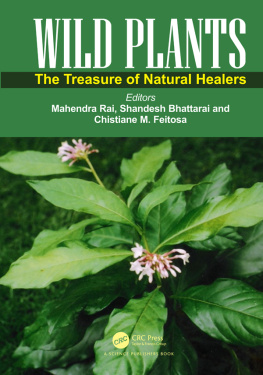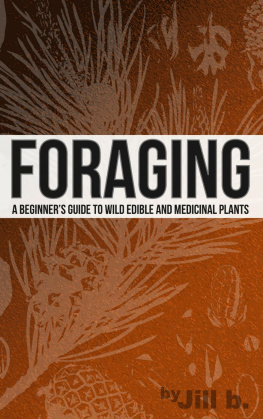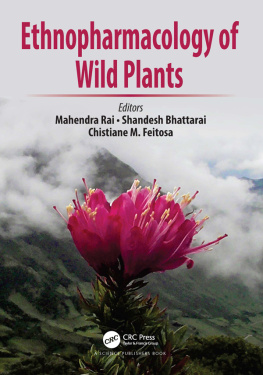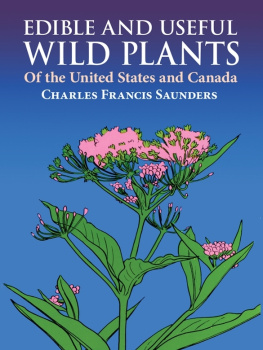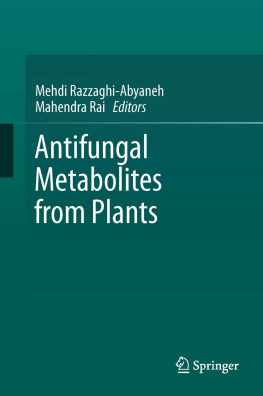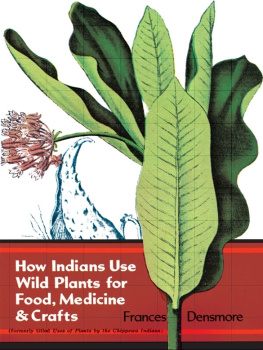Mahendra Rai - Wild Plants
Here you can read online Mahendra Rai - Wild Plants full text of the book (entire story) in english for free. Download pdf and epub, get meaning, cover and reviews about this ebook. year: 2021, publisher: CRC Press (Unlimited), genre: Politics. Description of the work, (preface) as well as reviews are available. Best literature library LitArk.com created for fans of good reading and offers a wide selection of genres:
Romance novel
Science fiction
Adventure
Detective
Science
History
Home and family
Prose
Art
Politics
Computer
Non-fiction
Religion
Business
Children
Humor
Choose a favorite category and find really read worthwhile books. Enjoy immersion in the world of imagination, feel the emotions of the characters or learn something new for yourself, make an fascinating discovery.
- Book:Wild Plants
- Author:
- Publisher:CRC Press (Unlimited)
- Genre:
- Year:2021
- Rating:3 / 5
- Favourites:Add to favourites
- Your mark:
- 60
- 1
- 2
- 3
- 4
- 5
Wild Plants: summary, description and annotation
We offer to read an annotation, description, summary or preface (depends on what the author of the book "Wild Plants" wrote himself). If you haven't found the necessary information about the book — write in the comments, we will try to find it.
Wild Plants — read online for free the complete book (whole text) full work
Below is the text of the book, divided by pages. System saving the place of the last page read, allows you to conveniently read the book "Wild Plants" online for free, without having to search again every time where you left off. Put a bookmark, and you can go to the page where you finished reading at any time.
Font size:
Interval:
Bookmark:
Wild Plants as a Treasure of Natural Healers
Mahendra Rai,
Plants are primarily multicellular, mostly photosynthetic eukaryotes of the kingdom Plantae which are distributed worldwide. The evolution of plants has resulted from the earliest algal mats, through bryophytes, lycopods, ferns to gymnosperms, and angiosperms (www.encyclopedia.com). Plants in all of these groups continue to flourish in the environments in which they evolved and have some of the largest genomes among all organisms (Todd and Scott 2013). The largest plant genome (in terms of gene number) is that of Triticum asestivum, estimated to encode 94,000 genes (Brenchley et al. 2012), and thus nearly five times as many as the human genome. The first plant genome sequenced was that of Arabidopsis thaliana, which encodes about 25,500 genes (Arabidopsis Genome Initiative 2000). In terms of sheer DNA sequence, the smallest published genome is that of the Utricularia gibba at 82 Mb (28,500 genes) (Enrique et al. 2013), while the largest, from the Picea abies, extends over 19,600 Mb (encodes about 28,300 genes) (Nystedt et al. 2013).
The estimates for the number of described plant species in the world vary in literature (Groombridge and Jenkins 2002, Thorne 2002, Scotland and Wortley 2003, Chapman 2009, Funk et al. 2009, Chase et al. 2015, APG IV 2016, Christenhusz and Byng 2016, RBG Kew 2016, Shrestha et al. 2018). The updated publication revealed that the described and accepted number of plant species in the world to be about 374,000, of which nearly 308,312 are described and accepted, vascular plant species of which 295,383 are Angiosperms [monocots (74,273), eudicots (210,008), Gymnosperms (1,079), Ferns (10,560), and Lycopods (1,290)] (Christenhusz and Byng 2016). The estimated numbers of liverworts are 9,000 species (Crandall Stotler and Stotler 2000), 200250 hornworts (Villarreal et al. 2010), 12,700 mosses (Crosby et al. 1999, Cox et al. 2010), about 44,000 algae (Guiry 2012), amounts to a total of about 374,000 (~374,262) plant species worldwide. These numbers differ from earlier estimates by Chapman (2009), which has substantially lower estimates, with 310,129 as the total number of plant species, of which 281,621 are vascular plants, but a higher estimate is by Pimm and Joppa (2015), which states that there are an estimated 450,000 species. The largest vascular plant families are Orchidaceae (about 28,000 species), followed by Asteraceae (about 24,700 species) (Funk et al. 2009, Chase et al. 2015, Shrestha et al. 2018).
Large parts of the world are still in need of additional biological expeditions (Christenhusz and Byng 2016). The key countries that yield the greatest numbers of new species are Australia, Brazil, China, and New Guinea, although much smaller African, American, Pacific, and Central and tropical Asian countries also contribute substantial numbers (Zhang et al. 2014), but the newest species are perhaps to be established in the worlds biodiversity hotspots (Joppa et al. 2011). The top ten countries in the world with the highest number of vascular plants are as follows: Brazil (56,215), Colombia (51,229 species), China (32,200 species), Indonesia (29,375 species), Mexico (26,071 species), South Africa (23,420 species), Venezuela (21,073), USA (19,473 species), Ecuador (19,362 species), and India (18,664 species) (Groombridge and Jenkins 2002, Shrestha 2016, Shrestha et al. 2018).
The research on wild plants to identify the commercially valuable genetic and biochemical resources has been on for centuries, and is now well accepted. This review aimed to gather information about the treasures of wild plants and stress the necessity to unlock such treasures for the conservation of wild plant resources and traditional knowledge.
Wild plants denote species that are neither cultivated nor domesticated, but available from the natural habitat (Beluhan and Ranogajec 2010). Commonly, wild plants are unnoticed (Scoones et al. 1992), which include herbs, shrubs, trees, and grasses that grow without human help and are an important part of natures biodiversity. In the earliest period of human history, people used wild plants and animals as their primary food and medicine. These resources are culturally acceptable, cheap, and easily accessible to local people, particularly in remote regions (Bhattarai et al. 2006, 2009). Indigenous people have developed their traditional knowledge regarding wild plant use, conservation, and management.
The role of wild plants used for foods in peoples diets and medicine should not be underrated. There has been a growing interest in studying the consumption of wild food plants for sustainable use and management (Pfoze et al. 2011). Wild plants offer a diversity of food needed to sustain a rich and healthy diversity of insects, birds, and animals. Some insects feed off of specific plants so that a loss of a wild plant in an area could lead to the loss of an insect (www.praying-nature.com). Of the Earths half-million plant species, about 3,000 species have been used as crops, and only 150 species have been in large scale cultivation (Mohammed et al. 2008).
The difference between wild and domesticated species is not easy. Domestication is an extended and difficult process, and many plants are found in various stages of domestication as a result of human selection (Pegu et al. 2013). In most civilizations, the use of wild plants forms part of indigenous systems of knowledge and practice that have developed and accrued over generations (Slikkerveer 1994).
The global diversity of wild plants is very high but little is known about their food, medicinal, and other use-value. Wild plants are a potential source for the discovery of novel molecules and new bioactive compounds, mainly because of the environmental stress to which they are exposed (Cordell 2002, Balunas and Kinghorn 2005, Chin et al. 2006, Newman and Cragg 2007, Carvalho 2011, Atanasov et al. 2015). Many plant-derived drugs were revealed as a result of scientific follow-up of well-known plants used in ethnomedicine (Cordell 2002, Carvalho 2011), and main diseases, such as HIV and cancer, are being treated with an array of potential products derived from biodiversity (Balunas and Kinghorn 2005, Chin et al. 2006, Newman and Cragg 2007, Atanasov et al. 2015). Hence, modern medicine has also benefited from wild plants that were used as home herbal therapies (Cordell 2002, Balunas and Kinghorn 2005, Newman and Cragg 2007, Carvalho 2011).
Wild plants have been playing a major part as a source of foods and medicines, and have a vital socio-economic role through their use in fuelwoods, dyes, poisons, shelter, fibers, religious and ritual ceremonies. The use of wild plants in providing sources of income and livelihoods in rural areas is acknowledged globally (Jain 1963, Agyemang 1996, Moreno-Black et al. 1996, Sajeev and Sasidharan 1997, LaRochelle and Berkes 2003, Kar 2004, Sawain et al. 2007, Yesodharan et al. 2007, Patiri and Borah 2007, Kar and Borthakur 2007, 2008, Misra et al. 2008, Aryal et al. 2009, Kalaba et al. 2009, Giliba et al. 2010, Kutum et al. 2011, Legwaila et al. 2011, Sarmah and Arunachalam 2011, Singh and Rawat 2011, Seal 2011, 2012, Dutta 2012). The sustainable harvest of wild plants is very important, as it can offer vital resources as well as generate income for local people.
The usage of plants is not restricted to documented literature because copious knowledge is still available in traditional daily life (Cakir 2017). Globally, wild plants in traditional medicines have been increasingly used by various communities due to their significant role in maintaining good health (Mahapatra et al. 2019). About 50,000 plants are believed to be used in traditional medicine, but the exact number of medicinally useful constituents residing inside these 50,000 plants is still unknown (Gewali 2008). Hence, wild plants are becoming a part of a new way of thinking because of their hidden medicinal and food values, and in managing health, healthy food, food safety, and slow food movements (Yeil et al. 2019).
Font size:
Interval:
Bookmark:
Similar books «Wild Plants»
Look at similar books to Wild Plants. We have selected literature similar in name and meaning in the hope of providing readers with more options to find new, interesting, not yet read works.
Discussion, reviews of the book Wild Plants and just readers' own opinions. Leave your comments, write what you think about the work, its meaning or the main characters. Specify what exactly you liked and what you didn't like, and why you think so.

